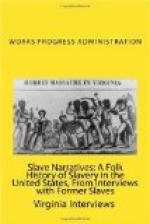“My father was a carpenter, whitewasher, anything. He was a common laborer. We didn’t have contractors then like we do now. Mother worked out in service too. Jimmie was the oldest boy. He taught school too.
“My father set the first table that was ever set in the Anthony Hotel, he was the cause of the first stove being brought here to cook on.
“Some of the children of the people that raised my mother are still living. They are Beebes. Roswell Beebe was a little one. They had a colored man named Peter and he was teaching Roswell to ride and the pony ran away. Peter stepped out to stop him and Roswell said, ’Git out of the way Peter, and let Billie Button come’.
“I get some commodities from the welfare. But I don’t get nothing like a pension. My husband worked at the Missouri Pacific shops for fifty-two years, and he don’t git nothing neither. It was the Iron Mountain when he first went there on June 8, 1879. He was disabled in 1932 because of injuries received on the job in March, 1931. But they hurried him out of the hospital and never would give him anything. That Monday morning, they had had a loving cup given them for not having had accidents in the plant. And at three p.m., he was sent into the hospital. He had a fall that injured his head. They only kept him there for two days and two hours. He was hurt in the head. Dr. Elkins himself came after him and let him set around in the tool room. He stayed there till he couldn’t do nothing at all.
“In 1881, he got his eye hurt on the job in the service of the Missouri Pacific. It was the Iron Mountain then. He was off about three or four months. They didn’t pay his wages while he was off. They told him they would give him a lifetime job, but they didn’t. His eye gave him trouble for the balance of his life. Sometimes it is worse than others. He had to go to the St. Louis Hospital quite often for about three or four years.
“When the house on Third and Cumberland was burnt, he rebuilded it, and the owners charged him such rent he had to move. He rebuilt it for five hundred dollars and was to get pay in rent. The owners jumped the rent up to twenty-five dollars a month. That way it soon took up the five hundred dollars. Then we moved to Eighth and Main. My brother Jimmie was in an accident there.
“He was pouring powder on a fire from an old powder horn and the flames jumped up in the horn and exploded and crippled his hand and burnt his face. Dr. Duel, a right young doctor, said he could cure them if father would pay him fifty dollars a piece. My sister was burnt at the same time as my brother. He had them make a thin dough, and put it over their faces and he cut pieces out for their eyes, and nose, and mouth. They left that dough on their faces and chest till the dough got hard and peeled off by itself. It left the white skin. Gradually the face got back to itself and took its right color again, so you couldn’t tell they had ever been burnt. The only medicine the doctor gave them was Epsom salts. Fifty dollars for each child. I used that remedy on a school boy once and cured him, but I didn’t charge him nothing.




